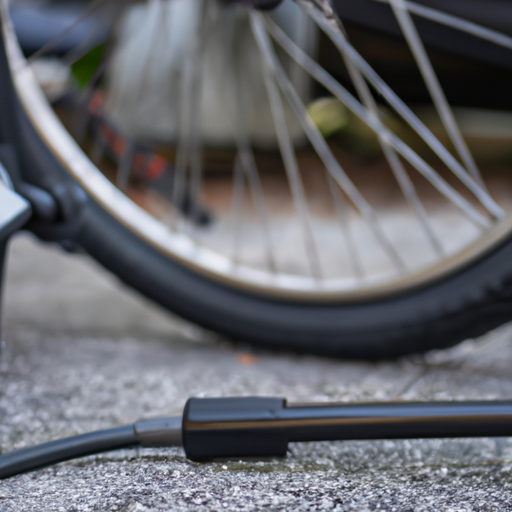Have you ever found yourself in a predicament with a flat car tire and a bike pump on hand? You may be wondering, can I actually inflate a car tire with a bike pump? Well, the answer might surprise you. Despite their apparent differences, it is indeed possible to use a bike pump to inflate a car tire. While it may take a bit of effort and patience, this handy tool can save the day in an unexpected situation. So, grab your bike pump and get ready to learn how to breathe life back into your car tire!
Table of Contents
Can I Inflate a Car Tire with a Bike Pump?
Have you ever found yourself in a situation where you need to inflate your car tire, but you don’t have access to a proper air compressor? Well, you might be wondering if it’s possible to use a bike pump to inflate your car tire. The good news is that, yes, it is indeed possible to inflate a car tire with a bike pump. Although it may not be the most efficient or convenient method, it can be a lifesaver in certain situations.
In this article, we will explore the different types of bike pumps, the components of a car tire, factors to consider, step-by-step guide to inflate a car tire with a bike pump, alternative methods, precautions to take, and the advantages and disadvantages of using a bike pump for inflating car tires.
Types of Bike Pumps
Before we dive into the process of inflating a car tire with a bike pump, let’s take a look at the different types of bike pumps available in the market. The most common types include floor pumps, mini pumps, and CO2 inflators.
- Floor Pumps: Floor pumps, also known as track pumps, are the largest and most powerful type of bike pump. They typically have a long hose and a large handle, which allows for efficient inflation with minimal effort. These pumps are not designed specifically for car tires but can be used in a pinch.
- Mini Pumps: Mini pumps are portable and compact pumps that are great for on-the-go use. They are smaller in size and generally have less pumping power compared to floor pumps. While mini pumps might not be as efficient, they can still get the job done in emergencies.
- CO2 Inflators: CO2 inflators use compressed CO2 cartridges to rapidly inflate a tire. They are lightweight, compact, and provide quick inflation. However, CO2 cartridges are single-use, so this method may not be the most cost-effective or environmentally friendly choice for inflating car tires.

Keep your car tires in peak condition with the right inflator.
Discovering the best tire inflator can be a game-changer for maintaining your vehicle. Explore our comprehensive Ultimate Guide to the Best Tire Inflators to make an informed decision.
Components of a Car Tire
In order to effectively inflate a car tire, it’s essential to understand its components. A typical car tire consists of the following parts:
- Tread: The tread is the outermost part of the tire that comes into direct contact with the road. It provides traction and grip.
- Sidewall: The sidewalls are the sides of the tire that connect the tread to the bead area. They provide additional support and protection to the tire.
- Beads: The beads are located on both sides of the tire and are designed to sit firmly on the wheel rim. They ensure a proper seal between the tire and the rim.
- Inner lining: The inner lining is a layer of rubber inside the tire that helps to retain the air pressure.
- Cords or plies: Cords or plies are layers of fabric or steel that provide strength and stability to the tire.
Understanding the different components of a car tire will help you ensure a successful inflation process.
Factors to Consider
Before using a bike pump to inflate your car tire, there are a few factors you need to consider. These include the type and size of your bike pump, the pressure required for your car tire, and the condition of your car tire.
Firstly, make sure you have a bike pump that is compatible with the valve on your car tire. Most car tires use either a Schrader or a Presta valve, so ensure that your bike pump can accommodate the valve type.
Secondly, check the recommended tire pressure for your car. This information can usually be found in the owner’s manual or on a sticker located inside the driver’s side door frame. It’s important to have an accurate pressure gauge on your bike pump to ensure you achieve the correct tire pressure.
Lastly, inspect your car tire for any damages, punctures, or uneven wear. If your tire is severely damaged or has a puncture, using a bike pump might not be a viable option. In such cases, it’s best to seek professional assistance or consider alternative methods.
Step-by-Step Guide to Inflate Car Tire with Bike Pump
Now, let’s walk through a step-by-step guide on how to inflate a car tire with a bike pump:
- Start by locating the valve stem on your car tire. It is usually found on the outer edge of the tire.
- Remove the valve cap from the stem and set it aside in a safe place.
- If your bike pump has a lever or switch to adjust between Schrader and Presta valves, ensure it is set to the correct valve type.
- Attach the pump head onto the valve stem firmly. Make sure it is securely attached to prevent any air leakage.
- Begin pumping the handle of the bike pump in a smooth and consistent motion. Depending on the size of your pump and the pressure required for your tire, it may take some time and effort to reach the desired pressure.
- Keep an eye on the pressure gauge on your pump. Once you reach the recommended tire pressure, stop pumping and remove the pump head from the valve stem.
- Quickly and securely replace the valve cap on the stem to prevent any dust or debris from entering.
- Check the tire pressure using a separate pressure gauge to ensure accuracy. If needed, adjust the pressure accordingly by repeating the above steps.
By following these steps, you can successfully inflate your car tire using a bike pump. However, it’s important to note that this method may take longer and require more effort compared to using a proper air compressor.
Alternative Methods
While using a bike pump to inflate a car tire is possible, it may not always be the most efficient or convenient option. Here are a few alternative methods you can consider:
- Gas Station Air Pump: Most gas stations have air pumps that are specifically designed for inflating car tires. These air pumps usually have a higher pressure output and can inflate your tires quickly and effectively. Keep some spare change handy as some gas stations may require payment for using their air pumps.
- Portable Air Compressor: Investing in a portable air compressor is a great solution for inflating car tires on the go. These compact devices are designed to easily fit in your car and provide quick and efficient inflation.
- Calling for Assistance: If you find yourself in a situation where you are unable to inflate your car tire, it may be best to reach out to a roadside assistance service or a professional mechanic who can assist you in inflating or replacing your tire.
Precautions to Take
When inflating a car tire with a bike pump, there are a few precautions you should keep in mind:
- Safety First: Always park your car in a safe location away from traffic before attempting to inflate your tire. This will help ensure your safety and the safety of other road users.
- Monitor Pressure: Regularly monitor the tire pressure while inflating to prevent overinflation or underinflation, as both can affect the performance and lifespan of your tire.
- Take Breaks: Inflating a car tire can be physically demanding, especially if using a bike pump. Take breaks if needed to avoid overexertion.
- Proper Storage: When not in use, store your bike pump in a clean and dry place to prevent any damage or deterioration.
By taking these precautions, you can minimize any potential risks and ensure a successful inflation process.
Advantages and Disadvantages
Using a bike pump to inflate a car tire comes with its own set of advantages and disadvantages. Let’s take a look at both:
Advantages:
- Portability: Bike pumps are typically compact and lightweight, making them easy to carry in your car or on a bike ride. This portability can be a life-saver in emergency situations.
- Cost: Compared to investing in a dedicated air compressor, a bike pump is a much more cost-effective option. It eliminates the need for additional equipment and saves you money in the long run.
- Versatility: Bike pumps can be used for multiple purposes, including inflating bike tires, sports equipment, and even inflatable toys. This versatility makes bike pumps a useful tool to have.
Disadvantages:
- Effort and Time: Inflating a car tire with a bike pump can be time-consuming and physically demanding, especially if you have a larger tire or require a higher pressure.
- Pressure Limitations: Bike pumps generally have lower pressure capacities compared to air compressors. This can be a limitation for larger car tires that require higher pressures.
- Accuracy: While some bike pumps have pressure gauges, they may not always be as accurate as dedicated pressure gauges. It’s recommended to cross-check the pressure with a separate gauge for accuracy.
Conclusion
In conclusion, it is possible to inflate a car tire with a bike pump. While it may not be the most efficient or convenient method, it can be a viable option in emergency situations or when access to a proper air compressor is unavailable. Remember to consider factors such as the type and size of your bike pump, the recommended tire pressure, and the condition of your tire before proceeding with inflation. Whether you choose to use a bike pump or explore alternative methods, ensure your safety and prioritize the proper maintenance and care of your car tires. Stay prepared and drive safely!

